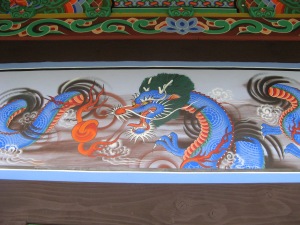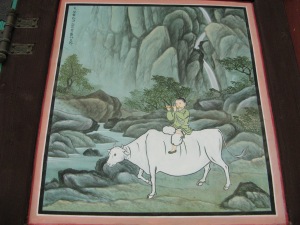THREE DAYS AT A TEMPLE – a visit to Yuongpyeongsa
May 2, 2017 Leave a comment
[The second in a series of three postings]
To get used to Korean cuisine is to risk addiction. It is the subtle herbal taste that they achieve with the traditional use of fermentation pots. This is especially true for ghimchi, cabbage, which may be prepared in literally hundreds of ways. As cabbage was my least favourite vegetable this was a small revolution in my dietary history. Pork is popular but in the monastery where I was, the food was vegetarian, and not less tasty. Years later when I ate Korean food in Cape Town again, I was catapulted into the aromas and the tastes of that remarkable food.
In the course of the day we met a nun, a sinewy woman with a natural radiance. She took us for a walk in the forests, pointing out the small wild flowers by the path. These, she told us, are not indigenous to the Korean peninsula. They were sown by the hands of American soldiers during the civil war of the early 1950s. Would that that had been all they left behind.
I took the opportunity to photograph the extensive paintings on the walls of the temple. I was especially charmed by the series portraying Buddha and the cow. There was one of a dragon which, I discovered to my surprise, is much loved in the East as a symbol of just kingship.
The Buddhism of South Korea is mainly Zen and this would take much to explain. The ideal, as I understand it, is to diminish resistance within oneself and to contemplate the Great Nothing. I can’t expect a non-Buddhist to grasp this. On the wall was the Zen symbol.
On Sunday morning we were invited to the head monk for tea, far more than a social event. He spoke to us through a translator about the ritual of tea drinking, which I found fascinating, but, I confess, that for me the green tea they drink is tasteless. In turn, they hate Western tea. He also spoke about the lotus flower, also a revelation for me. The lotus is a symbol throughout Asia, for Hindus, Buddhists and some Muslims.
He himself, a thick-set man, winked at us: on scattered occasions he takes a slice of pork and even a tot of whisky. On a shelf in his study there was a figure of the Emaciated Buddha before the revelation he had under the Bo-Tree: there needs to be balance between flesh and soul; you are not more spiritual if you disregard the body. Yet, the Emaciated Buddha, he said, has a message for humankind. Something to ponder.
© Will van der Walt
www.willwilltravel.wordpress.com
Les Semboules, Antibes
May, 2017
My photographs







